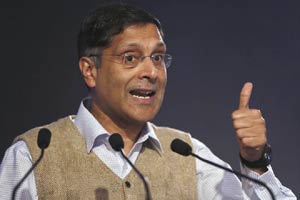In a recommendation that can break the political logjam over GST, a panel headed by the chief economic advisor today suggested 17-18 per cent GST rate and dropping of the one per cent additional tax on inter-state sales.
The Arvind Subramanian-headed panel, however, opposed inclusion of GST rate in the Constitution. The Congress has been demanding GST rate be included in the Constitution.
Describing GST as a historic opportunity to “Make in India by Making One India”, the panel has recommended a range for revenue-neutral rate (RNR) of 15-15.5 per cent for the proposed Goods and Services Tax (GST), with a preference for the lower one.
It also suggested a range of ‘standard’ tax rate of 17-18 per cent for bulk of goods and services while recommending 12 per cent for ‘low rate goods’ and 40 per cent for demerit goods like luxury car, aerated beverages, pan masala and tobacco. For precious metal, it recommended a range of 2-6 per cent.
While Subramanian at the press meet said the recommended standard rate is 17-18 per cent, an executive summary of the report released alongside suggested the rate to be between 16.9-18.9 per cent in a tabular form. The summary in narration, however, put the rate at 17-18 per cent.
Also, the panel recommended early inclusion of alcohol and petroleum products in GST.
“Bringing alcohol and real estate within the scope of the GST would further the government’s objectives of improving governance and reducing black money generation without compromising on states’ fiscal autonomy,” said the report, which was submitted to Finance Minister Arun Jaitley today.
The recommendations seem to suggest a middle-path approach in the deadlock between the Congress and the government, which didn’t want the GST rate to be part of the Bill as it would require a two-third majority approval of Parliament for any change in rates for any product in future.
The government wants the GST Bill to be approved in the current session of Parliament to meet the April 1, 2016, rollout deadline.
“This historic opportunity of cleaning up the tax system is not just necessary in itself, but also to support GST rates that facilitate rather than burden compliance,” the report added.
Talking to reporters, Subramanian said once the GST is implemented the indirect tax regime in India would be the best in emerging market economies and high income countries.
He said it was a “historic opportunity to rationalise exemptions that account for Rs 3.2 lakh crore or 2.5 per cent of the GDP.” The GST, which will create a uniform market, will cover 2-2.5 million tax entities.
Subramanian further said, the impact of implementation of GST on inflation is likely to be “minimal”, but there would be a need for monitoring.
Revenue Secretary Hasmukh Adhia said, “The government will study the report of the CEA-led committee on revenue neutral rate for GST and take a view on it.”
The final decision on rate, he said, “can only come from the policy choice that GST council makes for the rate structure and exemption limits”.
The Committee opined against providing a “band of rates” saying it complicates administration of the tax machinery.
“There are sound reasons not to provide for an administration-complicating band of rates, especially given the considerable flexibility and autonomy that states will preserve under the GST (including the ability to tax petroleum, alcohol, and other goods and services),” it said.
The report suggested that evaluation of GST implementation should not be taken over short-term period, but over longer period of time like 1-2 years.
It said elimination of any taxes on inter-state movement of goods would help promote Make in India and ease of doing business.
The report said facilitation of tax payer compliance and easy administration in early stages of roll out would help realising the benefits of GST and added that the aim should be to strive towards one-rate structure in the medium term.
Giving rationale for non-inclusion of GST rate in the Constitution, the report said, “setting a tax rate or an exemptions policy in stone for all time, regardless of the circumstances that will arise in future, of the macroeconomic conditions and of national priorities may not be credible or effective in the medium term”.

